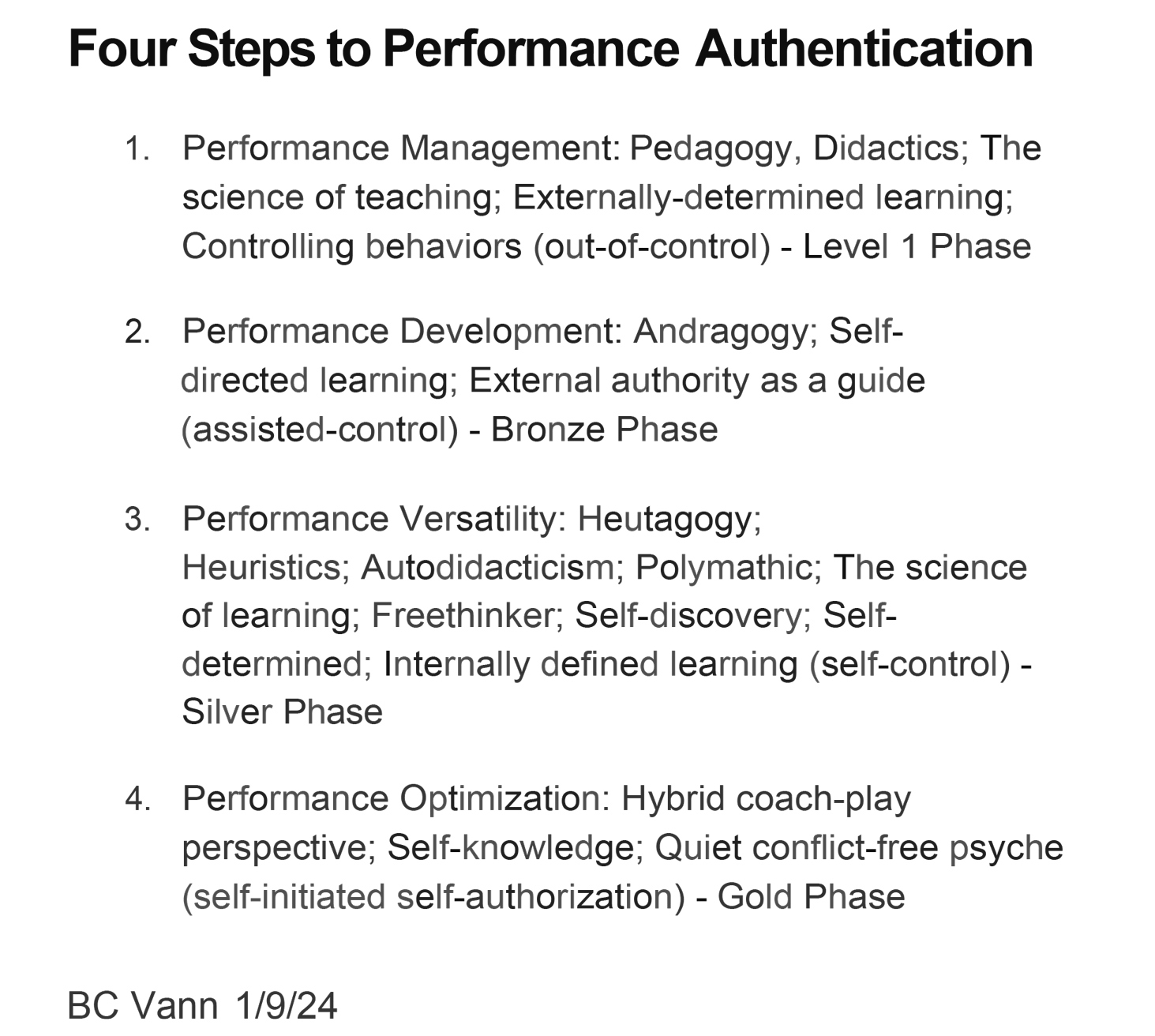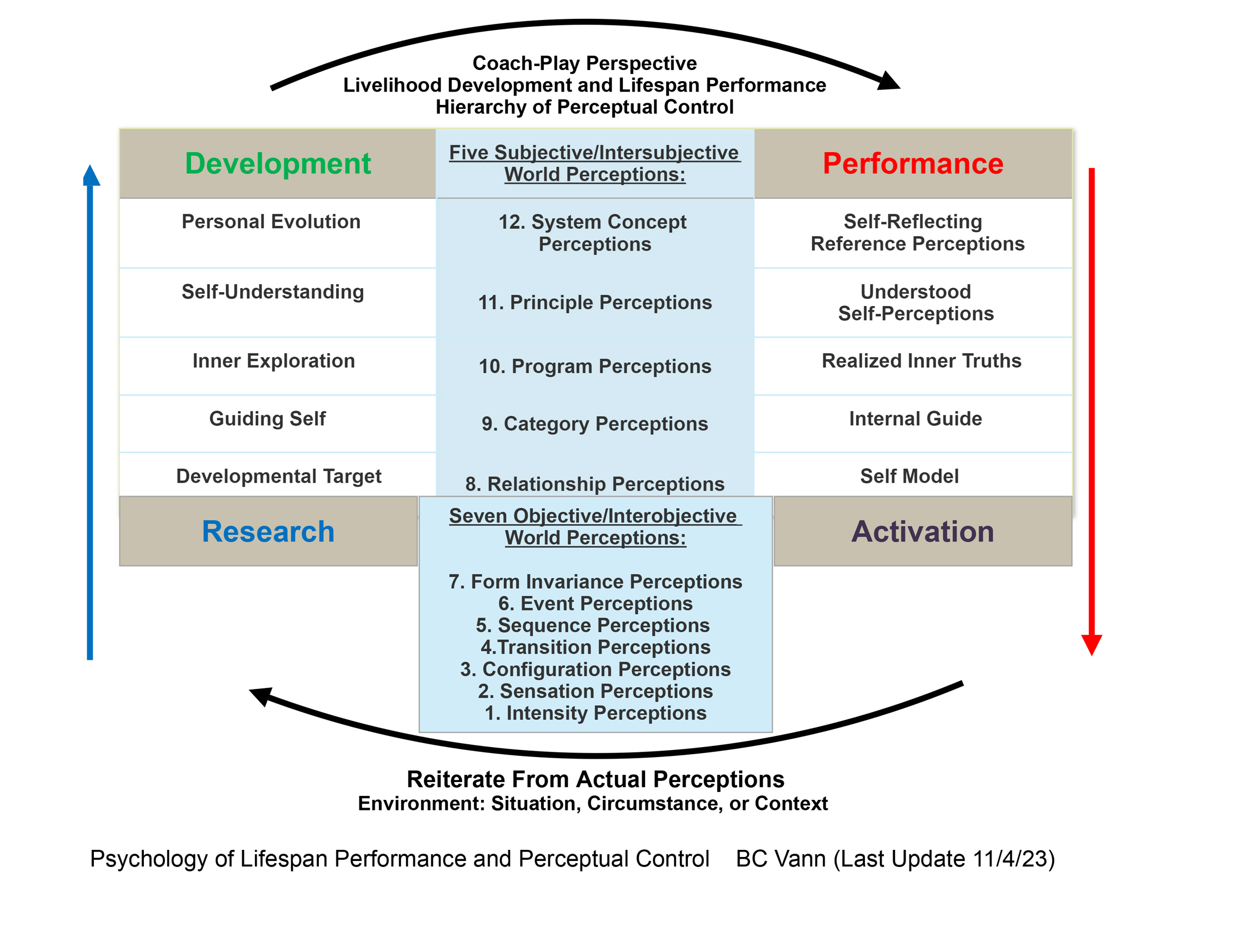As Your Resource For Self-Development
Step Three: Performance Versatility
(Last Update 3/13/25)
Performance Versatility represents another pivotal transition in the Four Steps to Performance Authentication. Having established the physical foundations during the first step, Performance Management, and having refined the emotional perspective in the second step, Performance Development. In the third step of four, we will concentrate on mastering the mental self. Here, individuals work through the power of self-directed learning, advancing from externally guided methods to an introspective, autonomous approach to problem-solving and decision-making. The focus is on learning higher-order thinking skills, evolving to an integrated cognitive framework, and mastering the full spectrum of mental intelligence, from basic inference to the complexities of systems thinking.

Mastery of the Mental Self
At its core, Performance Versatility emphasizes the evolution of a self-regulated mentality. With this internal shift, learners move past relying solely on external feedback to activate connections to the full capacity of their thought process. Here, we draw on the principles of heutagogy, which advocates self-determined learning, enabling individuals to take complete control of their intellectual progression. We are talking about a self-initiated approach to acquiring knowledge, comprehension, and the ability to apply that knowledge creatively and strategically during high-pressure situations.
Working through performance versatility encourages individuals to focus on mastering the four levels of intelligence. Traditional education focuses on Inference Thinking, the process of moving step by step from observation to conclusion. Performance Versatility takes students further by incorporating principle, perspective, and systems thinking.
- Principle Thinking enables learners to establish foundational truths by converting abstract concepts into solid, guiding principles.
- Perspective Thinking integrates multiple viewpoints and recognizes the inherent relativity in complex situations.
- Systems Thinking synthesizes disparate pieces of information into a coherent, comprehensive whole at this higher-order intelligence, the sensical ability to understand and predict causal relationships, allowing for simultaneous analysis of existence (historical, logical, psychological, and even cultural influences).
The crucial step of individual evolution toward mental mastery is concomitant with the evolution of the performance coaching industry. Here, we find that a correct strategic decision can distinguish a good performance from a great one, for instance, the handling of an athlete preparing for a critical tournament; in our previous steps for performance authentication, the emphasis would have been on perfecting physical mechanics and managing pre-competition anxiety. But here, in the third step, the athlete learns to think several steps ahead: anticipate opponents' moves, adapt strategies in real-time, and reflect on previous performances with a critical yet constructive mindset. Analyzing situations holistically and employing integrated thinking transforms raw talent into refined skill and prepares the individual for the next step, Performance Optimization.
Performance Versatility Functionality
A fundamental function of the Performance Versatility step is the promotion of autodidacticism, what the Optima Bowling Coach refers to as the hybrid coach-play perspective. This approach is supported by heuristics, mental shortcuts, or rules of thumb that streamline decision-making in complex environments. Usually, a speculative formulation serves as a guide or an educational method in which learning takes place through discoveries from investigations made by a student. Relying on heuristics, learners can more quickly process information and make effective decisions without being bogged down by excessive analysis. Also stressed here is continuous questioning and re-evaluation. Rather than accepting heuristic responses as final, individuals are taught to challenge their assumptions and refine their thought processes to elevate their mental mastery over time.
Here, we find the polymathic approach to intelligence; unfortunately, few people practice this particular quality of great or varied learning. However, in terms of performance versatility, being a polymath does not mean simply possessing knowledge across diverse subjects but the means to an integral insight in a trans-disciplinary manner to enhance problem-solving. For example, a coach at OptimaBowling.com might draw on knowledge from psychology, biomechanics, and even philosophy to develop innovative training strategies that address not only the physical mechanics of the sport but also its emotional and mental dimensions. This cross-disciplinary synthesis verifies Performance Versatility, an essential quality of individuals who see beyond conventional boundaries and explore creative solutions that might otherwise remain hidden.
Coaching Techniques and Tools
Coaches operating at the Performance Versatility step initiate exercises and reflective practices to stimulate intellectual growth. A standard method is scenario-based simulations. In these exercises, learners are presented with complex, often ambiguous situations requiring rapid, thoughtful responses. These simulations will force individuals to simultaneously engage multiple layers of thinking, employing inference, principle, perspective, and systems thinking to accomplish dynamic, real-time performance adjustments. Here, in step three, navigating situations and circumstances that accompany high-stress situations reflects a high level of complexity that necessitates learners develop an enhanced capacity for strategic thought by focusing on reaching mastery of their mental being.
Another technique is reflective practice, which utilizes a journal to note thoughts during training, competition, and everyday challenges. By periodically reviewing their diaries, learners will identify recurring thought patterns and evaluate the effectiveness of their strategies. By mastering mental harmonic energy flow and understanding why mental processes influence performance, this introspective practice becomes a transition from an exercise in self-observation to a vital tool for continuous improvement that empowers individuals to refine their cognitive strategies over time.
Perceptual Control
As touched on a couple of times above, the purpose of the Performance Versatility step is to reach mastery of the mental self. A deep commitment to the principle and practice of behavior as the control of perceptions supports this evolution. The mechanism discovered by applying the Perceptual Control Theory is the embodied cyclical, dynamic, psychological framework guiding self-regulation achieved through a hierarchy of negative feedback loops. At the mental level, attention is not directed toward physical actions or emotional harmony, but on continuously monitoring and adjusting the highest-level control loops (i.e., system concept, principle, and program perceptions). When conflicts arise between the perceived mental state and the intended reference state, the control system initiates corrective actions. This self-regulating process allows individuals to maintain a high-level focus and adaptability, even in rapidly changing circumstances. This natural capacity for self-correction is revealed when an individual recognizes a subtle deviation in a thought pattern being rectified by a necessary real-time adjustment.

The Coach
In addition to personal evolution, coaches who understand and apply the principles of Performance Versatility are better equipped to expand the coaching environment to one of intellectual curiosity and innovation as a partner to advance meaningful implications now found in their coaching ideology. Instead of focusing on physical drills or prescribing rote practices, the students are asked to focus on (1) becoming a freethinker, (2) Self-discovery, (3) Internally defined learning, (4) questioning the rationale behind their mechanics, and (5) experimenting with novel strategies. This collaborative, inquiry-based approach not only enhances the intellectual capacity of the athlete but also builds a deeper, more resilient connection between coach and player. As both parties enter their individual exploration and reflection process, they create a dynamic learning environment that continuously evolves in response to new insights and challenges.
Reaching Mental Mastery
The benefits of reaching mental mastery extend beyond performance coaching in today's complex and fast-paced world; thinking critically and adaptively is increasingly recognized as a vital skill across various disciplines. Whether in business, education, or creative pursuits, mental strategies mastered in the Performance Versatility step encourage individuals to deal with uncertainty, innovate in the face of challenges, and achieve sustainable success. The emphasis on self-regulation and continuous improvement will promote a resilient mindset in the face of setbacks and be capable of turning obstacles into opportunities for learning and growth.
Integrating higher-level thinking within the Performance Versatility framework serves as a bridge to the final step of the Four Steps to Performance Authentication, Performance Optimization. During the third step, individuals work on increasing their intelligence and laying the groundwork for the advanced cognitive processes required to master causal relationships and abstract reasoning. The skills of self-directed learning, reflective practice, and multi-layered thinking are essential for transitioning to Step Four, where comprehension and understanding of the world of ideas will optimize one's lifespan performance activations. Thus, Performance Versatility is not an endpoint but a critical functionality while working toward a fully integrated performance model.
Human Potential Movement
Working through the previous steps to expand one's grasp of the Human Potential Movement. We finally find that lessons are focused on unlocking the mind's full potential at the Performance Versatility step. Explained as advancements marked by the gradual accumulation of intellectual tools that teach individuals how to analyze, adapt, and innovate in real time. And to understand why the various forms of thinking, basic inferences that support everyday decisions to systems thinking, are required for complex problem solving, transform the mental perspective, enhance performance on the field or in the classroom, and a lifelong capacity for learning and adaptation, proof that the transformation achieved during this phase is profound. Athletes, coaches, and learners who successfully navigate the challenges here emerge with a heightened sense of intellectual clarity and ability to manage the complexities of modern performance. To learn that true mastery is not confined to physical prowess or emotional stability but extends to the intricate workings of the mind. Reaching the mastery of the mental self, individuals affirm that intellectual growth is a continuous journey and an essential component of a healthy psyche. This assumption supports the innovative coaching philosophy of OptimaBowling.com.
The Assumption
Performance Versatility clarifies that the self-realization of mental mastery requires an environment that values autonomy, interdisciplinary insight, and continuous refinement in the progression toward human potential development. Performance Versatility embodies the empowerment of transformative thought processes that create potent tools for strategic action: higher-order thinking, reflective practice, and self-discovery. Self-initiating inference, principle, perspective, and systems thinking, individuals not only enhance their immediate performance but also lay the intellectual groundwork for future innovation and excellence. With Performance Versatility, we are at the gateway to the highest human potential. We have set the stage for the advanced causal insights of the final step of redefining what it means to achieve a truly integrated performance, which we call Performance Optimization.
See More: Step Four: Performance Optimization
Return To: Step Two: Performance Development
Return To: Four Steps to Performance Authentication